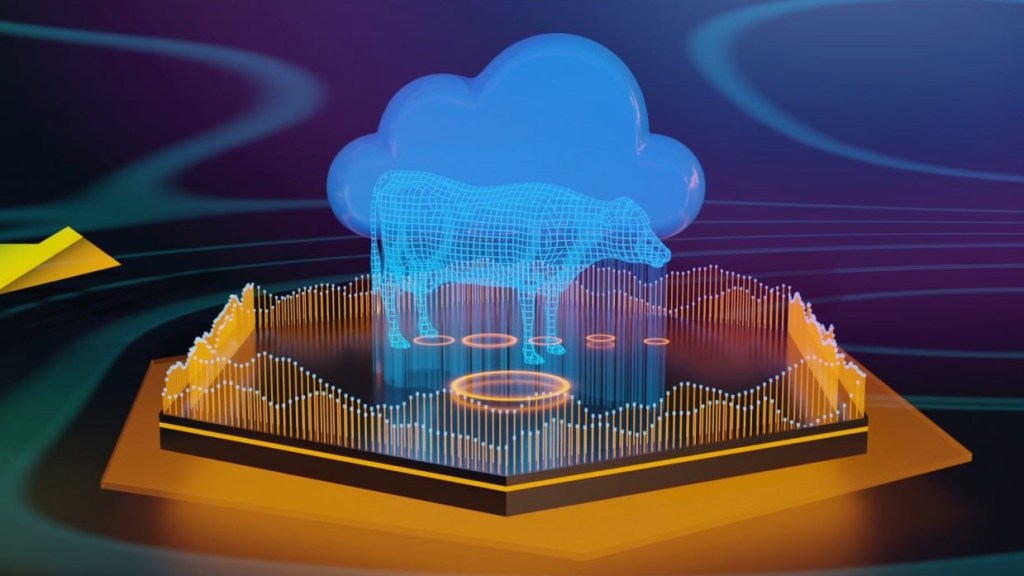Related news
Discover more stories about Mitacs — and the game-changing innovations driven by students and postdocs.
Classification of cows is the process by which a certified assessor scores animals for their strengths and weaknesses to enhance health, welfare, and longevity of the herd. Until now, this was a human-centered process conducted on scheduled days.
iClassifier, which was launched in 2021, is a Canadian startup that is looking to take artificial intelligence to farms and enhance the dairy cow classification process with a first-of-its-kind automated imaging system. It was founded by Reza Sabbagh, who is currently the company’s CEO and is an adjunct assistant professor in the Faculty of Engineering at the University of Alberta, Amir Rahvar, a data scientist and Chief Technology Officer of iClassifier, and Ghader Manafiazar, an animal scientist and assistant professor in the Department of Animal Science and Aquaculture at Dalhousie University, who serves as Chief Innovation Officer.
The company’s technology offers a more reliable and consistent alternative by capturing pictures or videos and processing them in the cloud using the company’s unique AI algorithm. These images can be taken either using a camera on a mobile app or a customized stall equipped with special cameras and imaging equipment.
As many as 25 different traits, such as stature, bone quality, pin width, and rump angle, can be measured for each cow. After thorough analysis, detailed reports with recommendations are provided to the farmers.
“Our goal is to increase profits for producers, save the planet through efficiency, and most importantly, take care of animal welfare and animal health,” said Manafiazar, noting that the company also plans to use its technology to bring original ideas to the dairy industry, such as defining new cow traits to help lower methane production or predict animal lameness. “Down the road, we anticipate there will be many new traits that this technology will be able to quickly adopt and define,” he said.
According to Manafiazar, not only do classified cows live longer and produce more milk, they also yield a net profit of $350 more per cow per year compared to non-classified herds. Yet some farms have discontinued or never used the process due to some barriers such as limited resources and inconsistency.

With the help of Mitacs interns, iClassifier has been able to advance their technology, and gain access to resources, making their innovative product a success.
University of Alberta Mechanical Engineering Master’s student Emran Hamzehnezhad is one of three Mitacs interns recruited by the company. As part of the internship, he collected data at the Edmonton-based Dairy Research and Technology Centre and Alberta-based farms.
He is currently analyzing the data in the Optical Diagnostics lab at the university as he works to develop the early lameness detection system by applying cutting-edge technologies such as deep learning networks, animal pose estimation, and image and signal processing to proactively monitor cattle on a farm. Right now, farmers typically detect lame cows only after the condition becomes serious or visible by human eye.
According to Hamzehnezhad, this internship has been a “remarkable opportunity to collaborate with passionate individuals who are devoted to animal welfare and contributing to agricultural progress” while also providing invaluable experience to support him in his career.
CEO Sabbagh also believes that the collaboration with Mitacs has been extremely fruitful in giving the company access to resources, lab facilities, and the specialized skill sets needed for iClassifier to prove the scale of the technology, explaining that the company is leveraging the equipment and staff available at University of Alberta’s Optical Diagnostics Group.
“Mitacs really facilitates these relationships in a way that we can rely on. It’s not like we submit a proposal and then wait for a long time to get results. We start working with our research partners in a timely manner that fits well with a start-up’s schedule,” he said.
The project also received support from Alberta Innovates.
After receiving help from the Mitacs interns, the company is now ready to test its product, with their first pilot project expected to be underway on a Canadian dairy farm by Spring 2024.
iClassifier also unveiled its technology at Gitex Northstar — the world’s largest startup event — held in Dubai in October 2023, during which the company emerged as a semi-finalist pitcher.
Early system metrics indicate a less than 2 percent discrepancy between the classification measurements generated by the automated system compared to actual measurements. The future goal is to shift the technology to help with the health and welfare of other livestock, including horses, swine and camels.
“When we surveyed farmers, they showed great interest in having iClassifier’s innovative technology on their farms and are even ready to participate in the technology development,” added Sabbagh. “Our service not only evaluates traits, but does the analysis for them, giving them the information they need to keep their herds healthy and maximize profits.”
Mitacs’s programs receive funding from valued partners across Canada. We thank the Government of Canada, the Government of Alberta, the Government of British Columbia, Research Manitoba, the Government of New Brunswick, the Government of Newfoundland and Labrador, the Government of Nova Scotia, the Government of Ontario, Innovation PEI, the Government of Quebec, the Government of Saskatchewan, and the Government of Yukon for supporting us to foster innovation and economic growth throughout the country.
Do you have a business challenge that could benefit from a research solution? If so, contact Mitacs today to discuss partnership opportunities: BD@mitacs.ca